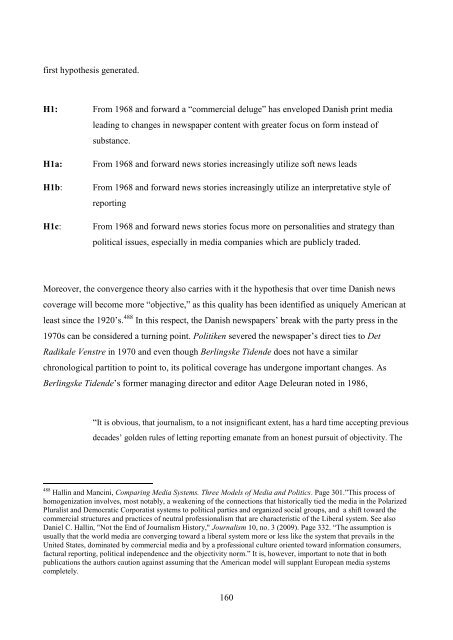The Jeremiad Over Journalism
The Jeremiad Over Journalism
The Jeremiad Over Journalism
You also want an ePaper? Increase the reach of your titles
YUMPU automatically turns print PDFs into web optimized ePapers that Google loves.
first hypothesis generated.<br />
H1: From 1968 and forward a ―commercial deluge‖ has enveloped Danish print media<br />
leading to changes in newspaper content with greater focus on form instead of<br />
substance.<br />
H1a: From 1968 and forward news stories increasingly utilize soft news leads<br />
H1b: From 1968 and forward news stories increasingly utilize an interpretative style of<br />
reporting<br />
H1c: From 1968 and forward news stories focus more on personalities and strategy than<br />
political issues, especially in media companies which are publicly traded.<br />
Moreover, the convergence theory also carries with it the hypothesis that over time Danish news<br />
coverage will become more ―objective,‖ as this quality has been identified as uniquely American at<br />
least since the 1920‘s. 488 In this respect, the Danish newspapers‘ break with the party press in the<br />
1970s can be considered a turning point. Politiken severed the newspaper‘s direct ties to Det<br />
Radikale Venstre in 1970 and even though Berlingske Tidende does not have a similar<br />
chronological partition to point to, its political coverage has undergone important changes. As<br />
Berlingske Tidende‘s former managing director and editor Aage Deleuran noted in 1986,<br />
―It is obvious, that journalism, to a not insignificant extent, has a hard time accepting previous<br />
decades‘ golden rules of letting reporting emanate from an honest pursuit of objectivity. <strong>The</strong><br />
488 Hallin and Mancini, Comparing Media Systems. Three Models of Media and Politics. Page 301.‖This process of<br />
homogenization involves, most notably, a weakening of the connections that historically tied the media in the Polarized<br />
Pluralist and Democratic Corporatist systems to political parties and organized social groups, and a shift toward the<br />
commercial structures and practices of neutral professionalism that are characteristic of the Liberal system. See also<br />
Daniel C. Hallin, "Not the End of <strong>Journalism</strong> History," <strong>Journalism</strong> 10, no. 3 (2009). Page 332. ―<strong>The</strong> assumption is<br />
usually that the world media are converging toward a liberal system more or less like the system that prevails in the<br />
United States, dominated by commercial media and by a professional culture oriented toward information consumers,<br />
factural reporting, political independence and the objectivity norm.‖ It is, however, important to note that in both<br />
publications the authors caution against assuming that the American model will supplant European media systems<br />
completely.<br />
160
















